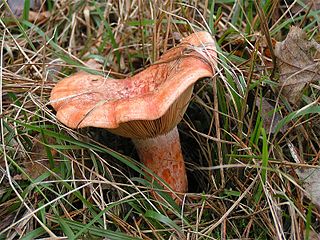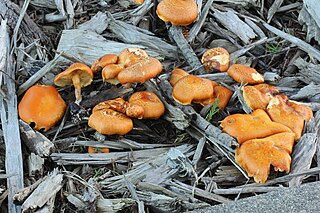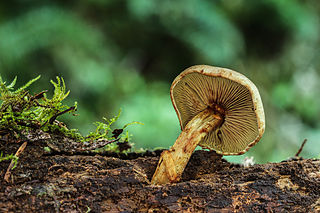
Lactarius deliciosus, commonly known as the delicious milk cap, saffron milk cap and red pine mushroom, is one of the best known members of the large milk-cap genus Lactarius in the order Russulales. It is native to Europe, but has been accidentally introduced to other countries along with pine trees, with which the fungus is symbiotic.

Gymnopilus junonius is a type of mushroom-forming fungus in the family Hymenogastraceae. Commonly known as the spectacular rustgill, this large orange mushroom is typically found growing on tree stumps, logs, or tree bases. Some subspecies of this mushroom contain the neurotoxic oligoisoprenoid gymnopilin.

Gymnopilus is a genus of gilled mushrooms within the fungal family Hymenogastraceae containing over 200 rusty-orange spored mushroom species.

Leratiomyces ceres, commonly known as the chip cherry or redlead roundhead, is mushroom which has a bright red to orange cap and dark purple-brown spore deposit. It is usually found growing gregariously on wood chips and is one of the most common and most distinctive mushrooms found in that habitat. It is common on wood chips and lawns in North America, Europe, Australia, New Zealand and elsewhere. The name Stropharia aurantiaca has been used extensively but incorrectly for this mushroom.

Gymnopilus luteofolius, known as the yellow-gilled gymnopilus, is a large and widely distributed mushroom that grows in dense clusters on dead hardwoods and conifers. It grows in late July to November in the east and in the winter on the west coast of North America. It has a rusty orange spore print and a bitter taste.

Gymnopilus aeruginosus, also known as the magic blue gym, is a mushroom-forming fungus that grows in clusters on dead wood and wood chip mulch. It is widely distributed and common in the Pacific Northwest. It has a rusty orange spore print and a bitter taste and contains the psychedelic chemical psilocybin. It was given its current name by mycologist Rolf Singer in 1951.

Gymnopilus purpuratus is a species of agaric fungus in the family Hymenogastraceae. It grows in clusters on dead wood, tree stumps and wood chip mulch. It is widely distributed and has been recorded in Argentina, Australia, Chile, New Zealand, the UK and Germany. It has a broadly convex cap covered in small dry reddish-brown scales, a stout yellow stem beneath reddish brown, wine-red to purple vertical fibres, and a thick rusty orange spore print.

Gymnopilus sapineus, commonly known as the scaly rustgill or common and boring gymnopilus, is a small and widely distributed mushroom which grows in dense clusters on dead conifer wood. It has a rusty orange spore print and a bitter taste. This species does not stain blue and lacks the hallucinogen psilocybin.

Gymnopilus liquiritiae is a mushroom in the family Hymenogastraceae. The mushroom is widely distributed and grows in dense clusters on dead conifer wood. It has a rusty orange spore print, a bitter taste, and does not contain the hallucinogen psilocybin. One of its key distinguishing features is the lack of partial veil.
Gymnopilus luteus, known as the yellow gymnopilus, is a widely distributed mushroom-forming fungus of the Eastern United States. It contains the hallucinogens psilocybin and psilocin. It is often mistaken for G. speciosissimus and G. subspectabilis.

Gymnopilus bellulus is a species of mushroom in the family Hymenogastraceae. It was given its current name by American mycologist Murrill in 1917. It is odorless, bitter in taste, and regarded as inedible.

Gymnopilus echinulisporus is a species of agaric fungus in the family Hymenogastraceae. It was first formally described by American mycologist William Alphonso Murrill in 1912.

Gymnopilus humicola is a species of mushroom in the family Hymenogastraceae.
Gymnopilus terrestris is a species of agaric fungus in the family Hymenogastraceae.

Gymnopilus subtropicus is a species of agaric fungus in the family Hymenogastraceae.
Gymnopilus subspectabilis, commonly known as the big laughing mushroom, laughing gym, or giant gymnopilus, is a species of agaric fungus in the family Hymenogastraceae which contains the hallucinogenic drug psilocybin.
Gymnopilus subbellulus is a species of mushroom-forming fungus in the family Hymenogastraceae.
Gymnopilus rufobrunneus is a species of mushroom-forming fungus in the family Hymenogastraceae.

Gymnopilus punctifolius is a species of mushroom in the family Hymenogastraceae found in North America.

Gymnopilus maritimus is a fungus species of the family Hymenogastraceae first collected in northern Sardinia, Italy, in 2006. The species produces moderately sized, sturdy mushrooms of a reddish-orange colour. The cap, which can measure up to 70 millimetres (3 in) across, is covered in orange fibrils, and sometimes has small scales. The yellowish stem measures up to 110 mm (4 in) in length by 8 mm (0.3 in) in width, and sometimes shows remnants of the partial veil. The mushrooms have thick gills of a variable colour, ranging from yellow to rust but staining darker, and the yellow flesh has a mild taste. The mushrooms leave a rusty-brown spore print, while the spores themselves measure from 7.5–11.5 micrometres (0.00030–0.00045 in) in length. The species is most similar in appearance to G. arenophilus and G. fulgens, but can be differentiated from both morphologically. Despite the similarities, it is not closely related to either, suggesting convergent evolution. Instead, within the genus Gymnopilus, it is most closely related to the spectabilis–imperialis clade. However, it is not particularly similar to any of its closest relatives.















